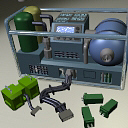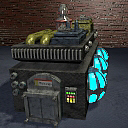|
|
 Power Systems
Power Systems
The numbers indicate a "tech level" corresponding to the History
section.
| Antimatter reactor |
2 |
Antimatter is released to react with matter. Big
energy results in the form of high-energy gamma rays which are
harvested into heat and electricity. Antiparticles may be
delivered to the ship by tanker, harvested raw from nature, or
produced by an on-board antimatter generator. They are stored in a
containment unit. |
| Compost system |
1
|
Every ship is a
closed environment with limited
resources and will generally have some sort of aggressive, highly
advanced waste reclamation system. In the case of a composter, all
the organic waste produced on the ship is gathered and exploited.
Engineered bacteriological agents and nanites are used to convert waste
products into reusable materials and energy. |
| Fuel cell |
1 |
 |
The fuel cell is a
highly functional, high scalable source of energy. Basically,
the fuel cell combines hydrogen and oxygen and produces
electricity and either water or steam. The water can be
reclaimed and easily split back into hydrogen and oxygen by
hooking up the fuel cell to an external energy source. |
Fuel cells are used almost like
batteries, to provide extra power beyond normal reactor levels under
duress, and their reaction reversed by power from the reactor during
normal running. In systems that produce steam, it can itself be
harvested and used to drive turbines as a secondary source of
electricity. Fuel cells also make excellent power sources for
localized sections of starships and for specific onboard equipment
and vehicles. |
| Fusion Reactor |
1 |
| Nuclei of atoms are
fused together in an endothermic reaction. The energy of the
fusion reaction is harvested by a Concipital Trajector Field,
which converts the heat and molecular kinetics from the reaction
into DC electricity.
Fusion reactors are a fairly common source of power,
particularly as supplementary or backup power sources. They tend
to simple, safe, reliable sources of power from plentiful fuel
sources.. |
 |
|
| Particle Furnace |
|
The particle furnace uses
rotated
particles as fuel, using quantum fields to control the release of energy from their
Blind dimension and harnessing the resulting dirty energy with a
Concipital Trajector Field to
create heat and electricity.
Rotated particles see fairly common use in handheld weapons but are
not suitable for similarly sized power sources. Large, delicate
quantum field generators are needed to control their reversion to
the Tangible state in a manner that is safe and controlled enough to
produce harnessable power. This and the need for storing large quantities of
potentially dangerous rotated particles limits their use to large
reactor-type installations suitable for powering starships and
cities. |
| Singularity generator |
6 |
"Small", artificially created black holes.
They spit off a number of interesting and useful particles,
including matter/antimatter pairs, as well as a certain amount of
heat. The smaller the singularity, the more energy it releases.
They need to be fed matter or they become unstable and explode in a
burst of intense radiation. While they are tiny, the equipment used
to contain the singularity and harvest its products is enormous.
They are generally only found on massive ships, outposts, and
stations. |
| Solar |
1 |
Every ship is a closed environment with
limited resources and will generally have some sort of aggressive, highly
advanced passive energy collection system. Passive energies
emitted by suns can be harvested and stored for later use or to
power self-charging nanites. |
Storage & Distribution
| The electrical power used to power a starship is
buffered through a very complicated containment and storage
system. A series of isolators, batteries, and capacitors are used
to buffer, clean, and store the energy for a variety of uses. The
whole system is controlled by biocomputers and proactively regulates
and distributes power.
|
 |
Starship power systems generally involve a reactor which
ultimately creates electrical power. The electrical power is
boosted up or down to appropriate power levels through transformers and its flow controlled by
isolators. The electricity is portioned to various systems and
stored for later use in batteries. Before being applied to
systems, it will be conditioned through capacitors. Carbon nanotube
ultracapacitors may
also be charged to provide short bursts of energy far beyond the levels the power systems
can normally produce.
As a whole, the power distribution and
conditioning system of a starship is generally referred to as the
Feednet and is usually controlled and regulated intelligently by
biocomputer Encephalons. |
|
|